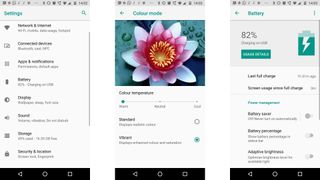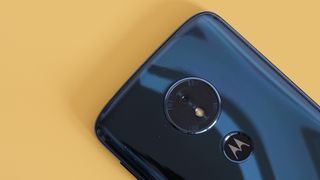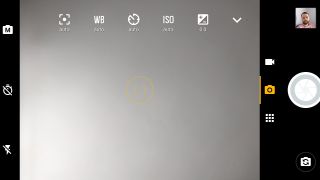Why you can trust TechRadar
Battery life
- Big 4,000mAh battery comfortably lasts all day
- Fast charging gets you from 0 to 100% in under two hours
A large battery is one of the Moto G6 Play’s key features. It has a 4,000mAh cell, 1,000mAh bigger than the Moto G6’s. In theory this phone should last for ages.
This mostly plays out with real world use. On one day testing we ended up going down a YouTube rabbit hole, watching an hour or more’s worth of video about people dropping anvils onto toilets and letting insects sting them. The internet happens to us all sometimes.
Even at midnight, with a full day’s worth of the usual messaging, photo-taking and a few hours of podcast streams, the Moto G6 Play still had just under 30% battery left.
With lighter use you should find you have 40-50% left by bed time.

It didn’t do that well in our standard playback test, though. 90 minutes of video at maximum brightness takes 18% off the charge level.
That’s good, but is not close to the 9% drop we’ve seen in phones like the Huawei P20 Pro. And it's also slightly worse than the 16% drop experienced by the Moto G5S, which is a little disappointing.
It would seem the new 18:9 LCD is a bit of battery hog even if it is relatively low-res. Though it comfortably beats the 21% loss exhibited by the standard Moto G6.
Charging speed is best-in-class, though. The Moto G6 Play has true Motorola TurboPower fast charging, which gets you from flat to 100% charge in under two hours.
As usual, the first 50% or so is replenished very quickly, and charging slows in the final stretch.
Camera
- 13MP single-lens camera performs decently in daylight
- Slow to shoot
- Struggles at night
The Moto G6 Play has a 13MP camera on the back with an LED flash and an f/2.0 lens. It’s a similar spec to the Moto G5.
We asked Motorola for details on the exact sensor used, but that info wasn’t available. It’s likely the phone uses a Sony or Samsung sensor, and may even use different hardware between territories.
You get all the same benefits and drawbacks we saw in the Moto G5. The main positive is very solid image quality when shooting during the day.
Use the default Auto HDR mode and you can take some lovely shots. The software bumps up dynamic range so your images look pretty good even if there’s quite a lot of light variance in the scene. No one wants blown-out highlights or a foreground that looks super-dim.
Color is well-saturated but fairly natural and we didn’t see any color temperature disasters, where a phone mis-judges the light and skews all color tones as a result.
As the Moto G6 Play and Moto G6 do not have top-tier image processing or image signal hardware, the results tend to vary fractionally between shots. But in daylight the G6 Play can often rival its more expensive brother for image quality, although it does suffer from purple fringing with some high light contrast scenes.

The Moto G6’s Auto HDR mode seems, surprisingly, more reliable than the G6 Play’s too. It is as if it has an extra level it can reach too when required to avoid blowing highlights, and uses a more effective HDR level more often.
This frankly doesn’t make a whole lot of sense when HDR is largely software-based, and doesn’t rely entirely on the native dynamic range of the camera sensor when shooting in daylight.
At night the disparity between the Motos widens. The Moto G6 Play camera struggles at night just like every other budget 13MP phone.
You have to manually alter the exposure dial, which appears by your focus point, when shooting very dark scenes. Otherwise you end up with a near-black image. And when you do, your photos will look vague.
Post-processing can’t help much either. Even though the Moto G6 Play reports using much lower ISO sensitivity than the Moto G6 in ultra-low light, open up the results in Photoshop and there’s little shadow detail to be recovered. It’s the usual sacrifice of using relatively low-end camera hardware.
Strangely enough, though, the Moto G6 Play actually lets you do more to help low-light performance using the manual mode than the G6, with launch software at least. This manual mode lets you set things like the shutter speed, white balance and ISO, just like an SLT camera.
Flip the shutter speed to manual and you can slow it down to 1/1.5 of a second. This is usually far too slow to result in a sharp picture handheld, but by taking around four seconds using, we assume, multiple merged exposures, it lets you take sharp, much-improved low light pics.

It’s not close to the kind of low light performance we saw in the Huawei P20 Pro. But is a nice half-hidden extra for those willing to dig deeper. Normal night photos are also sharper than those of entry-level 13MP cameras of a couple of years ago.
All issues explained so far are typical of a cheaper phone. Shooting speed is the one lingering disappointment.
Use the Auto HDR mode, sensible if you want the best results, and the camera feels a little slow. There’s a little shutter lag, a little processing lag. Shooting does not feel instant, and you can only take roughly one shot a second. Switch off HDR and the speed improves a little but not enough.
Relatively slow shooting speed was an issue with the G5 family of Moto phones, and it affects the more expensive Moto G6 too. This is a real shame as it’s one of the phone’s few grating issues.
The app is easy to use, though, and has just a couple of useful extra modes. There’s Panorama and slo-mo video, to add to the Manual mode. As there’s just a single rear camera, you don’t get the background blur seen in the more expensive Moto Gs.
The phone crops into the view a little when shooting video, in order to stabilize footage, but you can only capture at up to 1080p, 30 frames per second.
Around the Moto G6 Play’s front sits an 8MP selfie camera. As you’d expect for the price, though, this is not a high-end sensor and doesn’t get close to the detail and dynamic range of, for example, the Pixel 2’s front camera.
It does the job, though, and there’s a relatively subtle Beauty mode to zap your eye bags.
Camera samples










Current page: Battery life and camera
Prev Page Introduction, key features and design Next Page Anything else I should know?Andrew is a freelance journalist and has been writing and editing for some of the UK's top tech and lifestyle publications including TrustedReviews, Stuff, T3, TechRadar, Lifehacker and others.

